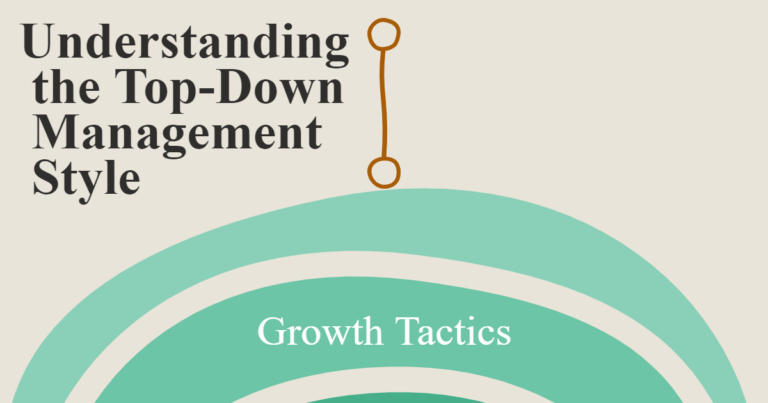A top-down management style is a leadership style where decisions and strategies are determined at the top or executive level of an organization. The overall approach involves upper management setting goals, making important decisions, and then communicating directives to lower-level employees to implement.
The main characteristics of top-down management include:
- Hierarchical structure where authority flows from the top down
- Strategic planning and decision-making are driven by upper management
- Directives and mandates issued by leadership for employees to follow
- Limited input solicited from lower levels of the organization
- Leaders maintain control and authority over decision-making
- Focus on achieving organizational goals and objectives
Essentially, top-down management centralizes power and authority with higher-level executives and managers. The priorities, vision, and directives come from the top. Lower levels are then responsible for carrying out the specifics of implementation, without much say in the broader strategy or decision-making process.
Jump To Section
History and Origins of Top-Down Management Style
The top-down management approach originated in the early 20th century as large corporations like General Motors and DuPont were being built in America. It was influenced by industrialists and efficiency experts like Frederick Taylor who pioneered concepts like scientific management.
The top-down approach was well suited to the assembly line techniques used in mass production. Decisions were made at the top by senior executives and passed down to lower levels to be implemented. There was little input from lower-level workers.
Henry Ford was an early adopter of top-down management for his automobile plants. He exerted tight control over operations with little delegation. The military was also an early proponent of top-down management and chain-of-command principles.
As corporations grew larger and more complex, the top-down approach helped maintain coordination and align activities to central goals. It remained the dominant management style through the mid-20th century.
How Top-Down Management Works

Top-down management is characterized by a hierarchical structure where decisions are made at the top or executive level of an organization. Information and directives flow from the upper management down to lower levels of managers and employees.
In a top-down approach, upper management makes major decisions related to company goals, strategies, and resource allocation. These decisions are then communicated to middle managers, who are responsible for implementing the broader plans. Middle managers may have some flexibility in execution but are still constrained by the overall decisions made at the top.
Frontline employees and lower-level staff have very little input in significant decisions in a strict top-down system. They are expected to carry out the plans passed down to them. There are clear divisions between upper management who do the thinking and planning, middle managers who disseminate directives, and the rank-and-file employees who execute tasks without much say.
The belief is that top executives have the most knowledge and perspective to make the best decisions for the organization as a whole. By centralizing decision-making, senior leaders can maintain tight control of the company’s direction and ensure alignment across departments. The top-down flow of information reinforces the hierarchy and authority structure.
Pros of Top-Down Management
Top-down management can provide several advantages when applied appropriately. Some pros of a top-down approach include:
Speed and Efficiency
With top-down management, decisions can be made quickly by executives who have a big-picture view of company strategy and goals. This enables organizations to pivot and adapt faster than with more decentralized approaches. Since there are fewer decision-makers, approvals can happen rapidly.
Alignment with Strategy
In a top-down structure, company leadership defines the vision, mission, objectives, and initiatives. Managers and employees work to carry out strategic plans developed at the executive level. This alignment ensures all efforts and resources are focused on common goals.
Control and Oversight
Top-down management allows upper management to maintain strong oversight and control. Executives can directly steer projects and operations in line with their priorities. This provides more quality assurance and risk management from the top. Leaders can also standardize processes and systems across the organization.
The hierarchical nature of top-down management gives leadership enhanced command, accountability, and governance over the organization. This allows efficient resource allocation and coordination.
Cons of Top-Down Management
Top-down management can have some significant downsides if not implemented thoughtfully. Some key cons to be aware of include:
- Lack of input from below: Because decision-making power is concentrated at the top levels in a top-down structure, there can be a lack of input and feedback from lower-level employees. This means top leaders may be making choices without a full view of operations, challenges, and ideas from the frontlines.
- Low morale and engagement: When employees feel they have no voice or agency in decision-making, it can negatively impact morale, engagement, and job satisfaction. Employees may feel frustrated and disempowered.
- Resistance to change: Changes mandated from the top down can sometimes be met with resistance or resentment on the ground level. Since employees don’t feel part of the decision process, they may be more likely to resist changes rather than embrace them.
Top-down leadership requires balancing directive leadership with efforts to gather input, engage employees, and communicate the reasoning for decisions. When employees feel heard and respected, even if not involved in final choices, they are more likely to get on board.
When to Use Top-Down Management

Top-down management can be an effective approach in certain situations, such as:
In a Crisis or Emergency
During a crisis or emergency, quick, decisive action is often needed. There may not be time for extensive collaboration or input from all levels of the organization. Top-down management allows leadership to respond rapidly and issue directives that will be followed. This command-and-control style can help stabilize an emergency.
For Short-Term Projects
For short-term projects with tight deadlines, top-down management can help drive focus and alignment. With clear objectives set from the start, teams can execute efficiently without getting bogged down in endless analysis and debate. The top-down style provides clarity of purpose and priorities.
With Inexperienced Teams
When leading a team that lacks experience and knowledge, top-down management gives the leader greater control. The leader can actively guide the team, set standards, and monitor progress. Without strong top-down leadership, inexperienced teams may flounder. As the team gains competency, the leader can transition to a more collaborative approach.
Examples of Top-Down Management
Top-down management is commonly seen in traditional corporate structures and organizations with more rigid hierarchies. Some examples include:
Autocratic Leadership Styles
Leaders who use a strict top-down approach often have more autocratic or authoritarian leadership styles. They make decisions independently without much input from lower-level employees. This type of top-down management is common in traditional corporations where upper management holds decision-making power.
Military and Government
The military relies heavily on top-down management, with orders coming from the top ranks down to lower-level personnel. This clear chain of command is necessary for quick and efficient decision-making. Government agencies also often use a top-down approach, with decisions coming from senior officials.
Traditional Corporations
Many traditional corporations have rigid hierarchies and adopt a top-down approach to management. Decisions flow from senior executives down to managers, supervisors, and staff. There are clear reporting structures with multiple layers of management. Large multinational corporations often utilize top-down management to align strategy across global divisions.
Alternatives to Top-Down

Top-down management is not the only approach to managing an organization. There are other styles that can be effective as well. Some alternatives include:
Bottom-up Management
With bottom-up management, decisions are made at lower levels of the organization and then flow upwards. This empowers employees to take initiative and be involved in the decision-making process. The focus is on ideas coming from the bottom and working their way to the top, rather than orders coming from the top down.
The advantage of this approach is increased employee engagement and better ideas coming from those doing the actual work. The downside is it can be slower and less aligned with overall company goals set at the executive level.
Democratic/Participative Management
This management style involves managers actively seeking input from employees at all levels when making important decisions. The goal is to tap into the knowledge and perspectives of the entire team.
While it takes more time and effort, this inclusive approach can lead to better ideas, get more buy-in for decisions, and increase workplace satisfaction. The risk is that it can slow down decision-making and lead to “design by committee.”
Hybrid Approach
Often the most effective approach is a hybrid that incorporates elements of top-down and bottom-up management. Strategic goals and priorities are set at the executive level, while managers empower employees to collaborate and provide input on how best to achieve those goals.
This balanced approach provides direction from the top while still encouraging innovation from the bottom. Many modern management experts recommend some form of hybrid model.
Making Top-Down Management Work
Top-down management can work effectively if implemented thoughtfully. Here are some tips:
Communication and transparency – With top-down management, decisions are made at the top without much input from lower levels. This can lead to resentment if employees feel out of the loop. Managers should communicate openly about decisions, provide context and rationale, and welcome feedback. Transparency builds trust.
Employee empowerment – Strict top-down management can disempower employees. Managers should provide opportunities for employees to take initiative and make meaningful contributions. Simple things like allowing employees to organize team events or choose creative solutions can make a difference. Empowered employees are more engaged.
Flexibility – Rigid, traditional top-down management leaves little room for flexibility. However, being open to employee ideas and adapting plans when needed leads to better outcomes. Managers should balance providing direction with being flexible to input. A hybrid approach takes advantage of a top-down structure while allowing bottom-up innovations.
With strong communication, employee empowerment, and flexibility, organizations can leverage the strengths of top-down management while engaging employees and encouraging innovation. A skilled manager finds the right balance.
Conclusion
Top-down management has its pros and cons. On the pro side, it can allow for quick and decisive decision-making from leadership who have a big-picture view of company goals. It works well in certain situations like emergencies or when strong leadership is needed. However, on the con side, it can disempower employees and stifle innovation from emerging organically at lower levels.
Overall, top-down management tends to work best in hierarchical organizations with a clear chain of command. It is well-suited to situations where quick, unified decisions are needed. However, it risks demotivating employees and suppressing ideas from below.
In summary, top-down management can be the right approach when strong leadership and alignment are critical. However, it needs to be balanced with some bottom-up input to avoid being too authoritarian. The ideal may be a hybrid approach that gets the best of both worlds.


